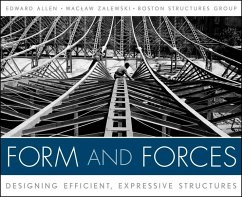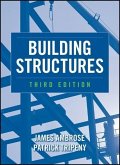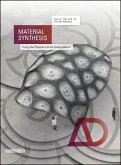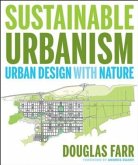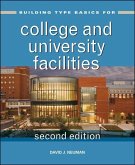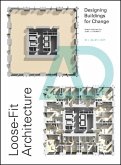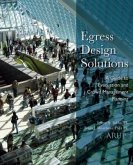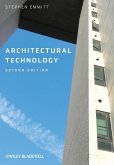- Gebundenes Buch
- Merkliste
- Auf die Merkliste
- Bewerten Bewerten
- Teilen
- Produkt teilen
- Produkterinnerung
- Produkterinnerung
Here, in one volume, is all the architect needs to know to participate in the entire process of designing structures. Emphasizing bestselling author Edward Allen s graphical approach, the book enables you to quickly determine the desired form of a building or other structure and easily design it without the need for complex mathematics. This unique text teaches the whole process of structural design for architects, including selection of suitable materials, finding a suitable configuration, finding forces and size members, designing appropriate connections, and proposing a feasible method of…mehr
Andere Kunden interessierten sich auch für
![Building Structures Building Structures]() James AmbroseBuilding Structures153,99 €
James AmbroseBuilding Structures153,99 €![Material Synthesis Material Synthesis]() Material Synthesis41,99 €
Material Synthesis41,99 €![Sustainable Urbanism Sustainable Urbanism]() Douglas FarrSustainable Urbanism88,99 €
Douglas FarrSustainable Urbanism88,99 €![Building Type Basics for College and University Facilities Building Type Basics for College and University Facilities]() David J. NeumanBuilding Type Basics for College and University Facilities95,99 €
David J. NeumanBuilding Type Basics for College and University Facilities95,99 €![Loose-Fit Architecture Loose-Fit Architecture]() Loose-Fit Architecture34,99 €
Loose-Fit Architecture34,99 €![Egress Design Solutions Egress Design Solutions]() Jeffrey TubbsEgress Design Solutions146,99 €
Jeffrey TubbsEgress Design Solutions146,99 €![Architectural Technology Architectural Technology]() Stephen EmmittArchitectural Technology64,99 €
Stephen EmmittArchitectural Technology64,99 €-
-
-
Here, in one volume, is all the architect needs to know to participate in the entire process of designing structures. Emphasizing bestselling author Edward Allen s graphical approach, the book enables you to quickly determine the desired form of a building or other structure and easily design it without the need for complex mathematics. This unique text teaches the whole process of structural design for architects, including selection of suitable materials, finding a suitable configuration, finding forces and size members, designing appropriate connections, and proposing a feasible method of erection. Chapters are centered on the design of a whole structure, from conception through construction planning.
Hinweis: Dieser Artikel kann nur an eine deutsche Lieferadresse ausgeliefert werden.
Hinweis: Dieser Artikel kann nur an eine deutsche Lieferadresse ausgeliefert werden.
Produktdetails
- Produktdetails
- Verlag: Wiley & Sons
- Artikelnr. des Verlages: 14517465000
- 1. Aufl.
- Seitenzahl: 640
- Erscheinungstermin: 1. September 2009
- Englisch
- Abmessung: 221mm x 283mm x 38mm
- Gewicht: 1670g
- ISBN-13: 9780470174654
- ISBN-10: 047017465X
- Artikelnr.: 26155468
- Herstellerkennzeichnung
- Libri GmbH
- Europaallee 1
- 36244 Bad Hersfeld
- gpsr@libri.de
- Verlag: Wiley & Sons
- Artikelnr. des Verlages: 14517465000
- 1. Aufl.
- Seitenzahl: 640
- Erscheinungstermin: 1. September 2009
- Englisch
- Abmessung: 221mm x 283mm x 38mm
- Gewicht: 1670g
- ISBN-13: 9780470174654
- ISBN-10: 047017465X
- Artikelnr.: 26155468
- Herstellerkennzeichnung
- Libri GmbH
- Europaallee 1
- 36244 Bad Hersfeld
- gpsr@libri.de
EDWARD ALLEN has taught for more than thirty years at the Massachusetts Institute of Technology, Yale University, and the University of Oregon. He is the bestselling author of Fundamentals of Building Construction, Fifth Edition. WAC¿AW ZALEWSKI is Professor Emeritus of Structural Design at the Massachusetts Institute of Technology.
Project Team and Contributors.
Acknowledgments.
Introduction.
1 Designing a Series of Suspension Footbridges.
Basic definitions of statics: Loads, Forces, Tension, Compression, Stress.
Free-body diagrams; Vectors and scalars; Static equilibrium of concurrent
forces.
The force polygon and funicular polygon for funicular structures; Bow's
notation.
Detailing steel rod elements in tension and anchoring to rock.
Lateral stability; stiffening a tensile structure.
Construction detailing and planning.
2 Designing a Suspended Roof.
Designing and detailing a suspended roof.
Designing funicular curves with specified properties.
Families of funicular curves.
Static equilibrium.
Components of forces.
Steel cable fastenings and details.
Lateral bracing.
Regulating forces on masts and backstays.
3 Designing a Concrete Cylindrical Shell Roof.
Shaping funicular arches and vaults in compression.
Form-finding: catenary, parabola, circle.
Stiffening compressive structures against buckling and unbalanced loadings.
Detailing and constructing a thin single-curvature shell.
4 Master Lesson: Designing a Trussed Roof.
Structural idea generation in three dimensions; The creative process.
Graphical truss analysis; Influence of truss form and depth on member
forces.
Creative latitude in structural design and positive interactions between
architects and engineers.
5 Designing a Building on a Vertical Site.
Moments of forces.
Equilibrium of nonconcurrent forces.
Graphical analysis of nonconcurrent forces.
Detailing and construction of a steel frame structure on a very difficult
site.
6 Designing with Multipanel Trusses.
Various methods of analysis for multipanel trusses.
Common truss configurations and their uses.
Developing and refining the form of complex trusses based upon forces and
connections.
Detailing and construction of a building with heavy timber trusses.
7 Designing a Fanlike Roof.
Extending graphical truss analysis to design fanlike structures both
compressive and tensile (cable-stayed).
Finding good forms and member forces for cable-stayed, fanlike, and
treelike structures.
Design and detailing issues using steel tube construction.
8 Designing Unreinforced Masonry (John A. Ochsendorf and Philippe Block).
Understanding, designing, and detailing traditional unreinforced masonry.
Stability of masonry vaults with ties, engaged and flying buttresses.
Load tracing and kerns.
Graphical analysis of arches of predetermined shape.
Design and formal vocabulary of funicular masonry arches and vaults.
9 Master Lesson: Designing a Concrete Shell Roof for a Grandstand.
Equilibrium in three dimensions of a composite structure; combining
funicular vaults and trusses.
Architectural and engineering interactions in designing forms and
construction processes.
Working in SI (metric) units.
10 Designing Efficient Trusses.
Reversing the graphical process to synthesize shapes of constant-force
trusses and arches.
Rapid assessment of truss efficiency by comparing force polygons.
Typical forms of constant-force trusses.
11 Designing Restraints for Funicular Structures.
Tensile and compressive strategies of restraint to resist change of shape.
Effects of unbalanced loads on structures.
12 Designing Shell and Membrane Structures (Michael H. Ramage).
Form-finding techniques applied to shell, tent, pneumatic, and membrane
structures.
Material constraints and opportunities.
Detailing lightweight structures.
13 Structural Materials.
Granular materials.
Solid materials.
How materials break.
Transmission of forces in solid materials.
Characteristics of a good structural material.
Common structural materials.
Concepts of stress and strain.
Factors of safety.
14 Master Lesson: Designing with the Flow of Forces.
Trajectories of principal stresses.
Strut-and-tie modeling; truss modeling.
Three patterns of force flow; applications of basic patterns to any
structural element.
Use of graphical truss solutions to find forces in truss models.
15 Designing a Bay of Framing.
Configuring building frames in three dimensions; laying out a framing plan.
Understanding bays, decking, joists, beams, girders, slabs, columns, and
framing materials.
Load tracing for gravity and lateral loads.
Bracing to resist lateral loads.
Criteria influencing design of bays in very tall buildings where lateral
loads predominate.
Integration with vertical transportation, life safety and egress planning,
mechanical systems.
16 Bending Actions on Beams.
Analysis of external load patterns on structures; quantifying and
simplifying external loadings.
Bending moments and vertical forces.
V and M diagrams; relationship to force polygons and funicular polygons.
Graphical and semigraphical constructions.
17 How Beams Resist Bending.
Resistance mechanisms of beams.
Lattice pattern of flow of forces.
Deflection calculations.
Development of mathematical expressions for bending stresses and web
stresses in rectangular beams.
Designing bays of wood framing.
18 Bending Resistance in Beams of Any Shape.
Properties of complex cross-sectional shapes.
Moment of inertia.
Composite action.
Designing bays of steel framing.
19 Designing Columns, Frames, and Load-Bearing Walls.
Types of columns: short, intermediate, long; buckling and deflection.
Designing column restraints; designing optimum forms for columns.
Load-bearing walls.
Portal frames, hinges.
Architectural and historical expressions of columns.
20 Designing a Sitecast Concrete Building.
Composite action of steel and concrete in concrete beams, slabs, and
columns.
Selection and design criteria for reinforced concrete framing.
Opportunities and constraints for slab openings.
Relationship of structural system to program.
Designing bays of reinforced concrete framing.
21 Master Lesson: Designing in Precast Concrete.
Multidisciplinary project design teams.
Medium-rise building planning and choice of framing systems.
Integration with life safety and egress planning.
Integration with mechanical and electrical services.
Designing with precast concrete framing elements.
22 Designing an Entrance Canopy.
Designing a constant force beam.
Deriving a beam profile from the bending moment diagram.
Assuring overall stability of an unusual structure.
Combined axial and bending stress in a beam.
Guidelines for shaping structures.
Afterword: Engineers and Architects.
Index.
Acknowledgments.
Introduction.
1 Designing a Series of Suspension Footbridges.
Basic definitions of statics: Loads, Forces, Tension, Compression, Stress.
Free-body diagrams; Vectors and scalars; Static equilibrium of concurrent
forces.
The force polygon and funicular polygon for funicular structures; Bow's
notation.
Detailing steel rod elements in tension and anchoring to rock.
Lateral stability; stiffening a tensile structure.
Construction detailing and planning.
2 Designing a Suspended Roof.
Designing and detailing a suspended roof.
Designing funicular curves with specified properties.
Families of funicular curves.
Static equilibrium.
Components of forces.
Steel cable fastenings and details.
Lateral bracing.
Regulating forces on masts and backstays.
3 Designing a Concrete Cylindrical Shell Roof.
Shaping funicular arches and vaults in compression.
Form-finding: catenary, parabola, circle.
Stiffening compressive structures against buckling and unbalanced loadings.
Detailing and constructing a thin single-curvature shell.
4 Master Lesson: Designing a Trussed Roof.
Structural idea generation in three dimensions; The creative process.
Graphical truss analysis; Influence of truss form and depth on member
forces.
Creative latitude in structural design and positive interactions between
architects and engineers.
5 Designing a Building on a Vertical Site.
Moments of forces.
Equilibrium of nonconcurrent forces.
Graphical analysis of nonconcurrent forces.
Detailing and construction of a steel frame structure on a very difficult
site.
6 Designing with Multipanel Trusses.
Various methods of analysis for multipanel trusses.
Common truss configurations and their uses.
Developing and refining the form of complex trusses based upon forces and
connections.
Detailing and construction of a building with heavy timber trusses.
7 Designing a Fanlike Roof.
Extending graphical truss analysis to design fanlike structures both
compressive and tensile (cable-stayed).
Finding good forms and member forces for cable-stayed, fanlike, and
treelike structures.
Design and detailing issues using steel tube construction.
8 Designing Unreinforced Masonry (John A. Ochsendorf and Philippe Block).
Understanding, designing, and detailing traditional unreinforced masonry.
Stability of masonry vaults with ties, engaged and flying buttresses.
Load tracing and kerns.
Graphical analysis of arches of predetermined shape.
Design and formal vocabulary of funicular masonry arches and vaults.
9 Master Lesson: Designing a Concrete Shell Roof for a Grandstand.
Equilibrium in three dimensions of a composite structure; combining
funicular vaults and trusses.
Architectural and engineering interactions in designing forms and
construction processes.
Working in SI (metric) units.
10 Designing Efficient Trusses.
Reversing the graphical process to synthesize shapes of constant-force
trusses and arches.
Rapid assessment of truss efficiency by comparing force polygons.
Typical forms of constant-force trusses.
11 Designing Restraints for Funicular Structures.
Tensile and compressive strategies of restraint to resist change of shape.
Effects of unbalanced loads on structures.
12 Designing Shell and Membrane Structures (Michael H. Ramage).
Form-finding techniques applied to shell, tent, pneumatic, and membrane
structures.
Material constraints and opportunities.
Detailing lightweight structures.
13 Structural Materials.
Granular materials.
Solid materials.
How materials break.
Transmission of forces in solid materials.
Characteristics of a good structural material.
Common structural materials.
Concepts of stress and strain.
Factors of safety.
14 Master Lesson: Designing with the Flow of Forces.
Trajectories of principal stresses.
Strut-and-tie modeling; truss modeling.
Three patterns of force flow; applications of basic patterns to any
structural element.
Use of graphical truss solutions to find forces in truss models.
15 Designing a Bay of Framing.
Configuring building frames in three dimensions; laying out a framing plan.
Understanding bays, decking, joists, beams, girders, slabs, columns, and
framing materials.
Load tracing for gravity and lateral loads.
Bracing to resist lateral loads.
Criteria influencing design of bays in very tall buildings where lateral
loads predominate.
Integration with vertical transportation, life safety and egress planning,
mechanical systems.
16 Bending Actions on Beams.
Analysis of external load patterns on structures; quantifying and
simplifying external loadings.
Bending moments and vertical forces.
V and M diagrams; relationship to force polygons and funicular polygons.
Graphical and semigraphical constructions.
17 How Beams Resist Bending.
Resistance mechanisms of beams.
Lattice pattern of flow of forces.
Deflection calculations.
Development of mathematical expressions for bending stresses and web
stresses in rectangular beams.
Designing bays of wood framing.
18 Bending Resistance in Beams of Any Shape.
Properties of complex cross-sectional shapes.
Moment of inertia.
Composite action.
Designing bays of steel framing.
19 Designing Columns, Frames, and Load-Bearing Walls.
Types of columns: short, intermediate, long; buckling and deflection.
Designing column restraints; designing optimum forms for columns.
Load-bearing walls.
Portal frames, hinges.
Architectural and historical expressions of columns.
20 Designing a Sitecast Concrete Building.
Composite action of steel and concrete in concrete beams, slabs, and
columns.
Selection and design criteria for reinforced concrete framing.
Opportunities and constraints for slab openings.
Relationship of structural system to program.
Designing bays of reinforced concrete framing.
21 Master Lesson: Designing in Precast Concrete.
Multidisciplinary project design teams.
Medium-rise building planning and choice of framing systems.
Integration with life safety and egress planning.
Integration with mechanical and electrical services.
Designing with precast concrete framing elements.
22 Designing an Entrance Canopy.
Designing a constant force beam.
Deriving a beam profile from the bending moment diagram.
Assuring overall stability of an unusual structure.
Combined axial and bending stress in a beam.
Guidelines for shaping structures.
Afterword: Engineers and Architects.
Index.
Project Team and Contributors.
Acknowledgments.
Introduction.
1 Designing a Series of Suspension Footbridges.
Basic definitions of statics: Loads, Forces, Tension, Compression, Stress.
Free-body diagrams; Vectors and scalars; Static equilibrium of concurrent
forces.
The force polygon and funicular polygon for funicular structures; Bow's
notation.
Detailing steel rod elements in tension and anchoring to rock.
Lateral stability; stiffening a tensile structure.
Construction detailing and planning.
2 Designing a Suspended Roof.
Designing and detailing a suspended roof.
Designing funicular curves with specified properties.
Families of funicular curves.
Static equilibrium.
Components of forces.
Steel cable fastenings and details.
Lateral bracing.
Regulating forces on masts and backstays.
3 Designing a Concrete Cylindrical Shell Roof.
Shaping funicular arches and vaults in compression.
Form-finding: catenary, parabola, circle.
Stiffening compressive structures against buckling and unbalanced loadings.
Detailing and constructing a thin single-curvature shell.
4 Master Lesson: Designing a Trussed Roof.
Structural idea generation in three dimensions; The creative process.
Graphical truss analysis; Influence of truss form and depth on member
forces.
Creative latitude in structural design and positive interactions between
architects and engineers.
5 Designing a Building on a Vertical Site.
Moments of forces.
Equilibrium of nonconcurrent forces.
Graphical analysis of nonconcurrent forces.
Detailing and construction of a steel frame structure on a very difficult
site.
6 Designing with Multipanel Trusses.
Various methods of analysis for multipanel trusses.
Common truss configurations and their uses.
Developing and refining the form of complex trusses based upon forces and
connections.
Detailing and construction of a building with heavy timber trusses.
7 Designing a Fanlike Roof.
Extending graphical truss analysis to design fanlike structures both
compressive and tensile (cable-stayed).
Finding good forms and member forces for cable-stayed, fanlike, and
treelike structures.
Design and detailing issues using steel tube construction.
8 Designing Unreinforced Masonry (John A. Ochsendorf and Philippe Block).
Understanding, designing, and detailing traditional unreinforced masonry.
Stability of masonry vaults with ties, engaged and flying buttresses.
Load tracing and kerns.
Graphical analysis of arches of predetermined shape.
Design and formal vocabulary of funicular masonry arches and vaults.
9 Master Lesson: Designing a Concrete Shell Roof for a Grandstand.
Equilibrium in three dimensions of a composite structure; combining
funicular vaults and trusses.
Architectural and engineering interactions in designing forms and
construction processes.
Working in SI (metric) units.
10 Designing Efficient Trusses.
Reversing the graphical process to synthesize shapes of constant-force
trusses and arches.
Rapid assessment of truss efficiency by comparing force polygons.
Typical forms of constant-force trusses.
11 Designing Restraints for Funicular Structures.
Tensile and compressive strategies of restraint to resist change of shape.
Effects of unbalanced loads on structures.
12 Designing Shell and Membrane Structures (Michael H. Ramage).
Form-finding techniques applied to shell, tent, pneumatic, and membrane
structures.
Material constraints and opportunities.
Detailing lightweight structures.
13 Structural Materials.
Granular materials.
Solid materials.
How materials break.
Transmission of forces in solid materials.
Characteristics of a good structural material.
Common structural materials.
Concepts of stress and strain.
Factors of safety.
14 Master Lesson: Designing with the Flow of Forces.
Trajectories of principal stresses.
Strut-and-tie modeling; truss modeling.
Three patterns of force flow; applications of basic patterns to any
structural element.
Use of graphical truss solutions to find forces in truss models.
15 Designing a Bay of Framing.
Configuring building frames in three dimensions; laying out a framing plan.
Understanding bays, decking, joists, beams, girders, slabs, columns, and
framing materials.
Load tracing for gravity and lateral loads.
Bracing to resist lateral loads.
Criteria influencing design of bays in very tall buildings where lateral
loads predominate.
Integration with vertical transportation, life safety and egress planning,
mechanical systems.
16 Bending Actions on Beams.
Analysis of external load patterns on structures; quantifying and
simplifying external loadings.
Bending moments and vertical forces.
V and M diagrams; relationship to force polygons and funicular polygons.
Graphical and semigraphical constructions.
17 How Beams Resist Bending.
Resistance mechanisms of beams.
Lattice pattern of flow of forces.
Deflection calculations.
Development of mathematical expressions for bending stresses and web
stresses in rectangular beams.
Designing bays of wood framing.
18 Bending Resistance in Beams of Any Shape.
Properties of complex cross-sectional shapes.
Moment of inertia.
Composite action.
Designing bays of steel framing.
19 Designing Columns, Frames, and Load-Bearing Walls.
Types of columns: short, intermediate, long; buckling and deflection.
Designing column restraints; designing optimum forms for columns.
Load-bearing walls.
Portal frames, hinges.
Architectural and historical expressions of columns.
20 Designing a Sitecast Concrete Building.
Composite action of steel and concrete in concrete beams, slabs, and
columns.
Selection and design criteria for reinforced concrete framing.
Opportunities and constraints for slab openings.
Relationship of structural system to program.
Designing bays of reinforced concrete framing.
21 Master Lesson: Designing in Precast Concrete.
Multidisciplinary project design teams.
Medium-rise building planning and choice of framing systems.
Integration with life safety and egress planning.
Integration with mechanical and electrical services.
Designing with precast concrete framing elements.
22 Designing an Entrance Canopy.
Designing a constant force beam.
Deriving a beam profile from the bending moment diagram.
Assuring overall stability of an unusual structure.
Combined axial and bending stress in a beam.
Guidelines for shaping structures.
Afterword: Engineers and Architects.
Index.
Acknowledgments.
Introduction.
1 Designing a Series of Suspension Footbridges.
Basic definitions of statics: Loads, Forces, Tension, Compression, Stress.
Free-body diagrams; Vectors and scalars; Static equilibrium of concurrent
forces.
The force polygon and funicular polygon for funicular structures; Bow's
notation.
Detailing steel rod elements in tension and anchoring to rock.
Lateral stability; stiffening a tensile structure.
Construction detailing and planning.
2 Designing a Suspended Roof.
Designing and detailing a suspended roof.
Designing funicular curves with specified properties.
Families of funicular curves.
Static equilibrium.
Components of forces.
Steel cable fastenings and details.
Lateral bracing.
Regulating forces on masts and backstays.
3 Designing a Concrete Cylindrical Shell Roof.
Shaping funicular arches and vaults in compression.
Form-finding: catenary, parabola, circle.
Stiffening compressive structures against buckling and unbalanced loadings.
Detailing and constructing a thin single-curvature shell.
4 Master Lesson: Designing a Trussed Roof.
Structural idea generation in three dimensions; The creative process.
Graphical truss analysis; Influence of truss form and depth on member
forces.
Creative latitude in structural design and positive interactions between
architects and engineers.
5 Designing a Building on a Vertical Site.
Moments of forces.
Equilibrium of nonconcurrent forces.
Graphical analysis of nonconcurrent forces.
Detailing and construction of a steel frame structure on a very difficult
site.
6 Designing with Multipanel Trusses.
Various methods of analysis for multipanel trusses.
Common truss configurations and their uses.
Developing and refining the form of complex trusses based upon forces and
connections.
Detailing and construction of a building with heavy timber trusses.
7 Designing a Fanlike Roof.
Extending graphical truss analysis to design fanlike structures both
compressive and tensile (cable-stayed).
Finding good forms and member forces for cable-stayed, fanlike, and
treelike structures.
Design and detailing issues using steel tube construction.
8 Designing Unreinforced Masonry (John A. Ochsendorf and Philippe Block).
Understanding, designing, and detailing traditional unreinforced masonry.
Stability of masonry vaults with ties, engaged and flying buttresses.
Load tracing and kerns.
Graphical analysis of arches of predetermined shape.
Design and formal vocabulary of funicular masonry arches and vaults.
9 Master Lesson: Designing a Concrete Shell Roof for a Grandstand.
Equilibrium in three dimensions of a composite structure; combining
funicular vaults and trusses.
Architectural and engineering interactions in designing forms and
construction processes.
Working in SI (metric) units.
10 Designing Efficient Trusses.
Reversing the graphical process to synthesize shapes of constant-force
trusses and arches.
Rapid assessment of truss efficiency by comparing force polygons.
Typical forms of constant-force trusses.
11 Designing Restraints for Funicular Structures.
Tensile and compressive strategies of restraint to resist change of shape.
Effects of unbalanced loads on structures.
12 Designing Shell and Membrane Structures (Michael H. Ramage).
Form-finding techniques applied to shell, tent, pneumatic, and membrane
structures.
Material constraints and opportunities.
Detailing lightweight structures.
13 Structural Materials.
Granular materials.
Solid materials.
How materials break.
Transmission of forces in solid materials.
Characteristics of a good structural material.
Common structural materials.
Concepts of stress and strain.
Factors of safety.
14 Master Lesson: Designing with the Flow of Forces.
Trajectories of principal stresses.
Strut-and-tie modeling; truss modeling.
Three patterns of force flow; applications of basic patterns to any
structural element.
Use of graphical truss solutions to find forces in truss models.
15 Designing a Bay of Framing.
Configuring building frames in three dimensions; laying out a framing plan.
Understanding bays, decking, joists, beams, girders, slabs, columns, and
framing materials.
Load tracing for gravity and lateral loads.
Bracing to resist lateral loads.
Criteria influencing design of bays in very tall buildings where lateral
loads predominate.
Integration with vertical transportation, life safety and egress planning,
mechanical systems.
16 Bending Actions on Beams.
Analysis of external load patterns on structures; quantifying and
simplifying external loadings.
Bending moments and vertical forces.
V and M diagrams; relationship to force polygons and funicular polygons.
Graphical and semigraphical constructions.
17 How Beams Resist Bending.
Resistance mechanisms of beams.
Lattice pattern of flow of forces.
Deflection calculations.
Development of mathematical expressions for bending stresses and web
stresses in rectangular beams.
Designing bays of wood framing.
18 Bending Resistance in Beams of Any Shape.
Properties of complex cross-sectional shapes.
Moment of inertia.
Composite action.
Designing bays of steel framing.
19 Designing Columns, Frames, and Load-Bearing Walls.
Types of columns: short, intermediate, long; buckling and deflection.
Designing column restraints; designing optimum forms for columns.
Load-bearing walls.
Portal frames, hinges.
Architectural and historical expressions of columns.
20 Designing a Sitecast Concrete Building.
Composite action of steel and concrete in concrete beams, slabs, and
columns.
Selection and design criteria for reinforced concrete framing.
Opportunities and constraints for slab openings.
Relationship of structural system to program.
Designing bays of reinforced concrete framing.
21 Master Lesson: Designing in Precast Concrete.
Multidisciplinary project design teams.
Medium-rise building planning and choice of framing systems.
Integration with life safety and egress planning.
Integration with mechanical and electrical services.
Designing with precast concrete framing elements.
22 Designing an Entrance Canopy.
Designing a constant force beam.
Deriving a beam profile from the bending moment diagram.
Assuring overall stability of an unusual structure.
Combined axial and bending stress in a beam.
Guidelines for shaping structures.
Afterword: Engineers and Architects.
Index.

